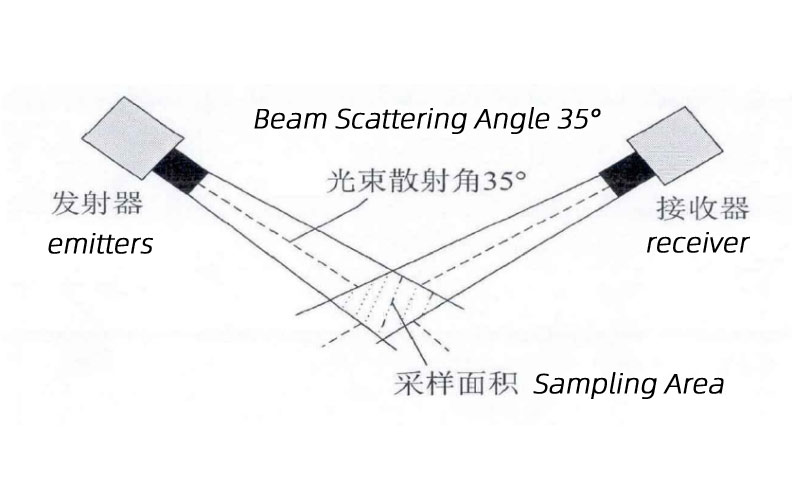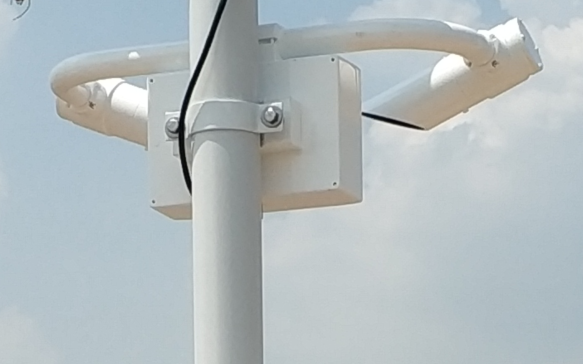

— Blogs —
—Products—
 Consumer hotline +8618073152920
Consumer hotline +8618073152920 WhatsApp:+8615367865107
Address:Room 102, District D, Houhu Industrial Park, Yuelu District, Changsha City, Hunan Province, China
Product knowledge
Time:2025-11-22 16:04:37 Popularity:99
As urbanization accelerates, extreme weather becomes more frequent, and atmospheric particulate concentrations rise, visibility has become one of the most critical meteorological parameters in transportation, urban management, and environmental monitoring. Numerous studies show a significant positive correlation between reduced visibility and road traffic accidents, flight delays, and vessel collisions. Consequently, global demand for visibility monitoring stations is growing rapidly — especially on highways, bridges and tunnels, airport runways, port terminals, and wind farms.
The NiuBoL visibility monitoring station was developed precisely to meet this need, delivering all-weather, all-environment intelligent automatic monitoring through high-precision optical scattering technology.
A visibility monitoring station is a specialized meteorological instrument that evaluates atmospheric transparency and light extinction conditions. It precisely measures the scattering intensity caused by airborne particles and calculates the horizontal distance an observer can clearly see under current conditions (“how far you can see”).
Compared with traditional human visual observation, it offers:
- 24/7 operation (day and night)
- Objective, high-precision results unaffected by subjective judgment
- Seamless integration into automated warning systems
- Ideal for long-term unattended operation
NiuBoL stations employ professional-grade optical paths with dust-proof and anti-mold coatings, dramatically slowing lens contamination and ensuring exceptional stability even in rain, snow, heavy fog, or severe pollution.
The NiuBoL visibility meter operates on the optical forward scatter principle.
A transmitter emits a beam of near-infrared light at a specific wavelength (875 nm) into the sampling volume. Suspended particles (fog droplets, haze, dust, etc.) scatter the light. The receiver collects scattered light within a 39°–51° forward scatter angle range and calculates the scattering coefficient from its intensity.
For visibility below 100 km, atmospheric extinction is almost entirely dominated by particle scattering, so the scattering coefficient can be treated as the total extinction coefficient — enabling highly accurate real-time visibility calculation.
- Forward-scattered light intensity is linearly proportional to particle concentration
- It minimizes interference from background sunlight and stray light
- It delivers outstanding stability across diverse weather conditions
This approach eliminates the long-baseline installation required by transmissometers, making it far more suitable for complex environments such as highways, bridges, and airports.

Atmospheric visibility is a key indicator of air quality, traffic safety, and weather conditions. It directly affects road travel, aircraft take-offs and landings, waterway navigation, and daily life. In an era of frequent fog and haze, a reliable, high-precision visibility monitoring system is no longer optional — it is essential for safety.
The NiuBoL visibility monitoring station uses advanced optics to continuously measure scattering characteristics of suspended particles, fog, haze, smoke, and dust, thereby calculating the maximum clear horizontal viewing distance. With its integrated optical design, anti-contamination structure, and high-level protection, it operates reliably in harsh conditions — whether on highways, airport taxiways, or coastal ports exposed to salt spray.
- Immune to background light interference (optical filtering + dual-receiver design)
- Highly consistent with human visual perception
- Accurate even at night or in low light
- Fast response with real-time output
High-stability infrared LED with multi-layer coated lens for low energy consumption, long lifespan, and minimal stray light interference.
Receiver (Optical Detection)
High-sensitivity photodetector with unique dual-receiver architecture dramatically improves resistance to intense sunlight, reflections, and vehicle headlights.
Embedded high-speed MCU performs:
- Data acquisition and algorithmic computation
- Conversion of scattering coefficient to visibility (MOR)
- Fault diagnostics
- RS485 communication output
Outputs complete data every 60 seconds and supports on-demand polling.

Designed for long-term outdoor deployment with industry-leading durability:
- Dust-repellent coating
- Anti-mold coating
- Oil-resistant surface treatment
→ Extends cleaning intervals (typically every 3 months)
- Hard-anodized aluminum + 316 stainless steel
- Multi-layer protective painting
- Full IP65 rating — perfect for high humidity, salt-spray, and coastal areas
- Reverse polarity protection
- Self-recovering fuses
- 15 kV ESD protection
- Lightning protection on power and communication ports
<1 W average — ideal for solar or battery-powered remote sites
Optical filtering + digital signal processing + hardware shielding ensures clean signals even under intense sunlight, extreme temperature swings, or thunderstorms.
Automatically detects lens contamination, signal anomalies, or voltage issues and reports fault codes via Modbus.
Prevents icing/frost on optical windows down to –40 °C in freezing rain or snow.
| Parameter | Specification |
| Power Supply | DC 12 V |
| Output Signal | RS485 (Modbus protocol) |
| Baud Rate | 9600 bps |
| Measurement Principle | 35° forward scatter |
| Light Source Wavelength | 875 nm (±100 nm bandwidth) |
| Scatter Angle Range | 39°–51° |
| Measurement Range | 5 m – 10 km |
| Accuracy | ≤2 km: ±2 %; 2–10 km: ±10 % |
| Average Power Consumption | 0.8 W |
| Operating Temperature | –40 °C to +80 °C |
| Operating Humidity | 0–95 % RH |
| Protection Rating | IP65 |
| Dimensions | 610 × 230 × 300 mm |
| Weight | <10 kg |
| Material | Hard-anodized aluminum + 316 stainless steel |
Real-time fog warning on motorways, bridges, tunnels, and fog-prone sections to enhance driving safety.
Deployed alongside runways and taxiways to provide critical visibility data for tower decision-making and ILS operations.
Supplies real-time visibility for vessel scheduling, berthing, and departure in coastal and inland waterways.
Accurate raw data for studying fog, haze, dust, and smoke dispersion.
Tracks cooling-tower plumes and pollutant dispersion ranges.
- Install in open, unobstructed areas
- Avoid direct sunlight into the receiver
- Keep away from strong reflective surfaces and pollution sources
- Mounting height ≥ 2.5 m recommended
Typical installation takes only minutes: fix pole → mount unit → connect power & comms → test.
- Standard Modbus-RTU over RS485 (up to 2000 m)
- Seamless integration with PLCs, RTUs, environmental systems, and weather stations
- Direct connection to NiuBoL cloud platform for remote alarms, trend graphs, historical storage, and open API
- Configurable thresholds trigger SMS/email alerts when visibility drops below set values

Fog detectors only indicate “fog present/absent”; visibility stations quantitatively measure exact distance with professional-grade accuracy required for highways and airports.
Accurate across fog, haze, smoke, and dust; more compact, energy-efficient, and stable than transmissometers.
No — dual-receiver + optical filtering effectively eliminates solar interference.
Yes — anti-contamination coatings and high-sensitivity optics maintain stability.
Lens cleaning every 3 months (more often in heavy dust areas).
Absolutely — average consumption only ~0.8 W.
Standard Modbus-RTU connects directly to any RTU, PLC, or monitoring system.
Open area, no obstructions, no reflective surfaces, no major pollution sources, avoid direct sun on receiver.
Below 5 m is extreme dense fog; above 10 km requires large-baseline transmissometers due to very weak scatter signals.
Professional surge protection on power and comms ports minimizes lightning damage risk.
As a professional manufacturer of meteorological and environmental instruments, NiuBoL has extensive expertise in optical measurement. Every unit undergoes rigorous testing: salt-spray corrosion, UV aging, vibration, damp-heat cycling, and extreme temperature shocks.
With 24/7 uninterrupted operation capability and global technical support, NiuBoL equipment is trusted in government projects, research institutes, traffic police systems, airport groups, and port authorities worldwide.

The NiuBoL visibility monitoring station is a flagship product that combines precision measurement, exceptional stability, ultra-low power consumption, IP65 protection, and professional optical design.
Thanks to its 35° forward scatter technology, dual-receiver anti-interference structure, and superior resistance to contamination and harsh weather, it delivers reliable, real-time visibility data on highways, airports, ports, and meteorological stations — forming a vital component of smart transportation, smart cities, and modern weather monitoring systems.
High reliability, minimal maintenance, and standardized interfaces make NiuBoL the trusted choice for safety-critical applications worldwide.
Related recommendations
Sensors & Weather Stations Catalog
Agriculture Sensors and Weather Stations Catalog-NiuBoL.pdf
Weather Stations Catalog-NiuBoL.pdf
Related products
 Combined air temperature and relative humidity sensor
Combined air temperature and relative humidity sensor Soil Moisture Temperature sensor for irrigation
Soil Moisture Temperature sensor for irrigation Soil pH sensor RS485 soil Testing instrument soil ph meter for agriculture
Soil pH sensor RS485 soil Testing instrument soil ph meter for agriculture Wind Speed sensor Output Modbus/RS485/Analog/0-5V/4-20mA
Wind Speed sensor Output Modbus/RS485/Analog/0-5V/4-20mA Tipping bucket rain gauge for weather monitoring auto rainfall sensor RS485/Outdoor/stainless steel
Tipping bucket rain gauge for weather monitoring auto rainfall sensor RS485/Outdoor/stainless steel Pyranometer Solar Radiation Sensor 4-20mA/RS485
Pyranometer Solar Radiation Sensor 4-20mA/RS485
Screenshot, WhatsApp to identify the QR code
WhatsApp number:+8615367865107
(Click on WhatsApp to copy and add friends)
